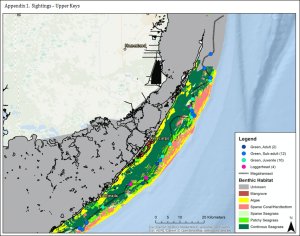Grant: 16-010R
Project Title: An Assessment of the Distribution of Large Immature and Adult Green Turtles Along Hawk Channel in the Florida Keys
Project Manager: Dean Bagley
Organization: Inwater Research Group (Non-Profit Organization)
Grant Amount: $22,084.00
Completion Date: 2020-11-09
Summary: With the extraordinary increase in green turtle nest numbers, it becomes even more important to understand other components of Florida green turtle life history, such as foraging areas. Vessel-based transect surveys will be used as the basis for a comprehensive survey of the distribution and abundance of large immature and adult green turtles along the length of Hawk Channel in the Florida Keys. Broad scale vessel–based transect surveys have the ability to generate quantitative data on species composition, abundance and distribution over large areas in an efficient and cost effective manner. IRG has used surveys of this type to successfully identify areas of high turtle abundance and high quality developmental habitat in the Lake Worth Lagoon, in the Big Bend area on Florida’s west coast, and in the Key West National Wildlife Refuge. We are proposing to conduct a 4-day vessel-based transect survey of Hawk Channel from Sands Key in Biscayne Bay to Rebecca Shoal, west of the Marquesas. We will use foraging destinations of satellite tracked adults and large immatures to determine whether the satellite turtles are foraging only in “hot spots” where there are other green turtles, or if there are green turtles uniformly distributed all along the Channel. The results of this study would provide valuable information to the National Marine Fisheries Service, the Florida Keys National Marine Sanctuary and to all other resource managers involved in the management of this protected species. Given the proven track record of this method and the documentation via satellite tracking data that adult green turtles use Hawk Channel as a migratory pathway, we feel this proposed research has great potential to identify specific areas for additional research and enhanced conservation measures. Results: Our transect route covered a distance of 364 kilometers. Turtles spotted during that time resulted a total of 196 sightings for analysis; 68 adult green turtles, 84 subadult green turtles, 35 juvenile green turtles and 9 loggerheads (6 adults, 1 subadult and one juvenile). Additional turtles were seen but if we were not able to identify the life stage, they could not be counted or included in the analysis. For instance, in the first two days, we spotted 4 green turtles and 4 loggerheads that were not distinguished between adult and subadult size class, therefore they could not be included. This means that our overall estimates will be on the low side. We overlaid the 196 turtle sightings (by species and life stage) and transect track on FWC’s Unified Reef Tract maps (see Appendix A). The percentage of turtles documented in each habitat type are as follows, based on those maps: patchy seagrass 33.2%, continuous seagrass 29.6%, sparse seagrass 11.2%, sparse coral/hardbottom 9.7%, algae 7.1%, bare sand 6.6%, unknown habitat 1.5%, patchy coral/hardbottom 0.5% and microalgae 0.5%. Average water depth over the length of the transect was 6.1 meters (range 2.3 to 11.8 meters). Water temperature ranged from 72-79 degrees F.
Results: Our transect route covered a distance of 364 kilometers. Turtles spotted during that time resulted a total of 196 sightings for analysis; 68 adult green turtles, 84 subadult green turtles, 35 juvenile green turtles and 9 loggerheads (6 adults, 1 subadult and one juvenile). Additional turtles were seen but if we were not able to identify the life stage, they could not be counted or included in the analysis. For instance, in the first two days, we spotted 4 green turtles and 4 loggerheads that were not distinguished between adult and subadult size class, therefore they could not be included. This means that our overall estimates will be on the low side. We overlaid the 196 turtle sightings (by species and life stage) and transect track on FWC’s Unified Reef Tract maps (see Appendix A). The percentage of turtles documented in each habitat type are as follows, based on those maps: patchy seagrass 33.2%, continuous seagrass 29.6%, sparse seagrass 11.2%, sparse coral/hardbottom 9.7%, algae 7.1%, bare sand 6.6%, unknown habitat 1.5%, patchy coral/hardbottom 0.5% and microalgae 0.5%. Average water depth over the length of the transect was 6.1 meters (range 2.3 to 11.8 meters). Water temperature ranged from 72-79 degrees F.